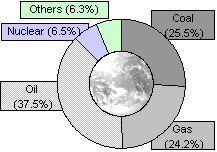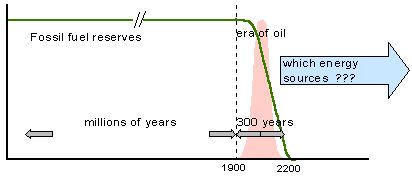|
Sources of energy
1
- Growing demand...
The progress of humanity cannot be achieved without energy
resources. All economic forecasts show that energy requirements are going to keep on
rising. This increase, the extent of which varies according to the type of scenario put forward
(the level of economic growth and whether environmental constraints are taken into account or not), has two main causes :
-
an increase in the world’s population, which
is predicted to rise from 6 billion in 2000 to 10 billion in 2050.
-
an increase in the energy requirements of developing countries.
The
present day total world energy consumption is around 8.5 billion oil equivalent metric tonnes (Gtep). Depending on the scenarios, it will be at between 20 and 40 Gtep in 2100. The increase in demand for electricity is likely to be even greater (increase by a factor of 2.5 to 3.5 by the year 2050).
|

Development in the consumption of primary energy
|
The 21st century will be a century for high energy requirements, both from a quantity (at least double) as a quality point of view (wider access to "commercial" energy).
2
- ... and decreasing resources
|
Fossil fuels today provide around 85% of requirements in primary energy and around 2/3 for electricity production. The known reserves of fossil fuels are limited to :
Consumption is posing more and more environmental problems (greenhouse effect) the scale of which is an ever more preoccupying issue . |

Breakdown of the world consumption
of primary energy (2002)
|

Depletion of fossil fuel reserves
In this context of limited energy resources and growing environmental constraints new energy scenarios must be put into operation. In simple terms, two major approaches exist :
-
the first is based on an extrapolation from the past, showing that there has always existed a dominant emerging source of energy for economic reasons: wood, then coal, and then oil. These scenarios forecast the dominance of gas in the first part of the 21st century, then nuclear energy and then fusion energy beyond 2100.
-
the second is based on the simultaneous use of a whole range of energy sources (solar energy, wind power and hydraulics) gradually and partially replacing fossil fuels. The economic aspect here gives up first place to a more ‘environmental’ vision of energy production.
To date no other viable approach has emerged. We may only note that each energy source offers advantages that we will have to learn how to exploit, while also taking care to take all the drawbacks involved in each solution into
account.
|
|